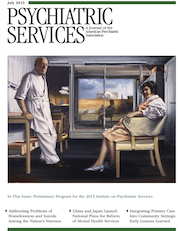Did Microinsults and Microaggressions Play a Role?
To the Editor: I found the outcome of the study published in the April issue—“Racial Differences in Veterans’ Satisfaction With Examination of Disability From Posttraumatic Stress Disorder” (1)—very interesting. On the basis of more than 40 years of working with African Americans, I found the conclusion unsurprising: “Ratings of disability examinations were generally high, although ratings were less favorable among African-American veterans than among Caucasian veterans.” These results clearly indicate that although America embraces the ideal of judging people by the content of their character and not the color of their skin, as a nation we have not yet been able to actualize it at all levels of society (2).
One explanation for why “race was significantly associated with overall rating of quality” might be the phenomena of “microinsults” and “microaggressions.” Dr. Chester Pierce defined these phenomena as subtle deprecating assumptions or stereotypes that cause perpetrators to infringe on the victim's times, space, energy, and mobility (3,4). Consider the example of a well-dressed African-American woman buying groceries at an upscale store and being asked by the European-American cashier for her food stamp card. Another example: an African-American man wearing a $500 three-piece suit is checking into a downtown hotel and is asked by a European-American hotel guest to help him with his bags.
Experience with African-American patients has taught me and others that these subtle behaviors are often at the root of the lack of trust and rapport that African-American patients have for examiners who lack cultural sensitivity (5) and who, as a result, are felt to be unwelcoming. Often when the African-American individual involved in these incidents shows offense, he or she is next asked “Why are you people so touchy?”
Therefore, I am curious. Were the authors aware of the phenomena of microinsults and microaggressions? And, if so, do they have an inkling of whether these dynamics may have played a role in their findings?
1 : Racial differences in veterans’ satisfaction with examination of disability from posttraumatic stress disorder. Psychiatric Services 64:354–359, 2013Link, Google Scholar
2 : Resolution Against Racism and Racial Discrimination and Their Adverse Impacts on Mental Health. Washington, DC, American Psychiatric Association, 2006. Available at www.psychiatry.org/practice/professional-interests/diversityomna/diversity-resources/apa-position-statements-related-to-diversityGoogle Scholar
3 : Overcome Prejudice at Work: The Harvard Medical School Guide. New York, RosettaBooks, 2013Google Scholar
4 : Challenges and obstacles in treating mentally ill black patients. Psychiatric Times, Dec 1, 2006, pp 48–49. Available at giftfromwithin.org/html/challeng.htmlGoogle Scholar
5 : Cultural competence; in Modern Community Mental Health: An Interdisciplinary Approach. Edited by Yeager KCutler DSwendsen D. New York, Oxford University Press, 2013Google Scholar



